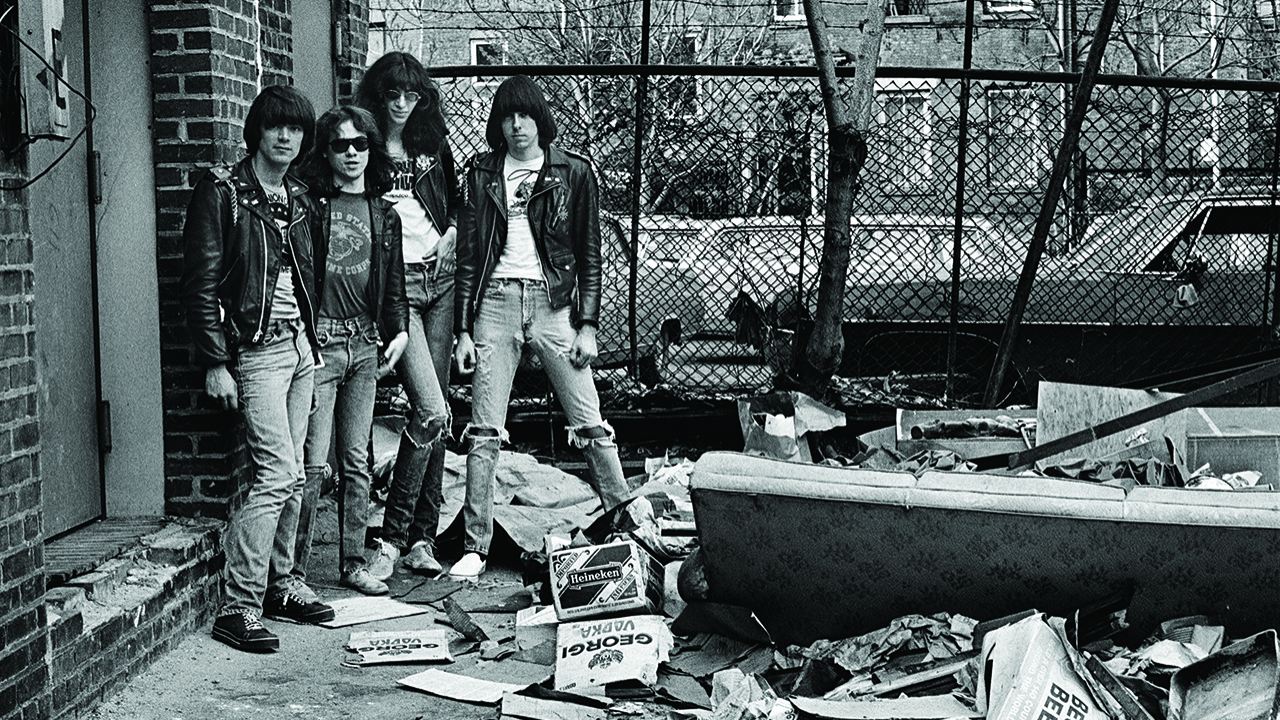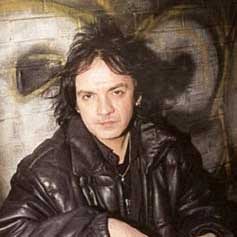This article originally appeared in Classic Rock #121.
July 5, 1976, and the striking black-and-white photograph on the cover of the Ramones’ recently released debut album has just come to life.
Four figures clad in regulation leather jackets, T-shirts, ripped jeans and sneakers have converged outside Dingwalls Dancehall in Camden, London. From my spot on a low wall outside the venue, they look like a mismatched alien biker gang who accidentally ended up on Earth after a wrong turn at Alpha Centauri.
The Ramones have literally just walked off stage after their first ever headline show in Britain, and I’m here to interview these freaky emissaries from New York for ZigZag magazine. Since their self-titled debut was released back in April, the buzz surrounding them has grown, and around us, key figures from London’s nascent punk community are out in force. The unmistakable Johnny Rotten hunches past. The newly formed Damned cavort loudly a few feet away. A skirmish is brewing between Stranglers bassist Jean-Jacques Burnel and The Clash’s Paul Simonon, whose own band played their first gig last night, supporting the Sex Pistols in a Sheffield pub. There’s a sense they’re all trying to get noticed by these exotic visitors.
But this is tame compared to their usual stomping ground on The Bowery, and the Americans don’t give it a second glance. Amiable, be-shaded drummer Tommy Ramone, who calls himself the band’s “spokesman and business guy”, settles on my right. To my left, mop-topped guitarist Johnny Ramone declares his love of horror films and John Denver, as livewire bassist Dee Dee Ramone chats animatedly to some fans. Towering before me, swaying from foot to foot, a strange smile plastered across his face, stands all six-foot-five of Joey Ramone, the gangling, otherworldy future icon who will utter just one carefully planned sentence as we chat.
An hour earlier, the four had careened through a set that wasn’t so much a collection of songs played one after the other as a sensory hit-and-run. With Johnny riffing like a buzzsaw, Joey gripping the mike-stand, and Dee Dee cavorting with his Fender Precision bass and bellowing the immortal intro “Wun-too-free-faw!” before each high-octane assault, the likes of Blitzkrieg Bop, Beat On The Brat and Now I Wanna Sniff Some Glue flew past as such velocity that, by the home stretch, there were no gaps between them, except when Dee Dee paused to lob a beer bottle he had just guzzled over his shoulder. The whole thing lasted 30 minutes. If anything was the ground zero of UK punk, then this was it.
Forty years after their world-changing debut album, the Ramones’ standing as one of the most original and influential bands in history is beyond argument. They were first to tell rock it had got fat, overblown and dull, then present a scorching new blueprint to replace it. Their secret weapon came from paying homage to the past rather than seeking to destroy it, taking their home city of New York’s classic pop legacy, stripping it down, speeding it up, then reimagining it all in a cartoon world populated by ridiculed Nazis, pinheads, perverts and punkettes called Sheena and Judy. They were the ultimate rock’n’roll gang. The original ‘Bruddas’.
Except that’s not quite true. As I found out when accompanying them on the road in the 70s, there was much more to the Ramones than just a blitzkrieg of noise delivered by four lovable cartoon characters operating under the same surname, and it was not all pleasant. Beneath the goofy banter and incendiary stage shows lurked intra-personal dysfunction, psychological wreckage and lifelong trauma. The united stance the Ramones presented was a lie.
“To the outside world they were this united front who never broke ranks, but individually they went separate ways,” says Mick Houghton, their original UK publicist. “They were like chalk and cheese.”

Looking back with hindsight, each Ramone was simply exaggerating their individual personal traits on stage from behind lines already drawn in the sand. The frontline were each dysfunctional in their own way. Johnny – born John Cummings and raised, like his bandmates, in the suburban enclave of Forest Hills, New York – was the heartless sergeant major, relentlessly pushing the band to keep the dollars flowing in,
a right-wing taskmaster with a chilling blue-eyed stare who carried around a log book of venues and called gigs “jobs”. Dee Dee – né Douglas Colvin – was the band’s doomed rock’n’roll heart, a former army brat who reacted to his upbringing by becoming a teenage delinquent, guzzling and ingesting anything to get him off as he sold his body on Manhattan’s meat rack at 53rd & 3rd, later immortalised in the Ramones song of the same name. “Dee Dee was very damaged,” Lemmy, a close friend and supporter of the Ramones, once observed. “There was always that baggage he carried around. I never thought he was happy.” Then there was Joey – Jeffrey Hyman to his mother – the tall, sickly outsider with an encyclopedic knowledge of pop music who wanted to be a star. He was born with a baseball-sized tumour on his spine, which was surgically removed but still left him with lifelong health problems.
“He was prone to infections because his neurological system was not right,” says Joey’s younger brother Mickey Leigh (aka Mitchell Hyman). “If he stepped on something and cut his foot, he would wind up in hospital on intravenous antibiotics. He was always going to the doctors.”
Joey’s problems were compounded by the undiagnosed Obsessive Compulsive Disorder (OCD) which would dominate his life from early teens onwards. “It was something that was always there and he always had to struggle with,” says Leigh. “These voices in his head would say, ‘You didn’t close this door right, you gotta do it again.’ He would do it 20 times until it was ‘right’. Because of what was going on in his head, he was different.”
Joey’s mental and physical issues didn’t stop him embracing the hippie lifestyle. When he was 18, he moved to San Francisco only for it to end in disaster when he got robbed of all his money. He returned to New York with a foot infection, which took several months to clear up, though not before being caught up in a drugs bust in Greenwich Village – something which shook him up badly.
“This had to be the most critical, pivotal stage of our development,” says Leigh. “This is essentially when Joey Ramone was born; different, disadvantaged and undaunted.”
Ironically, it was the most level-headed member of the Ramones who had gone through the most difficult upbringing. In 1957, at the age of eight, Tamás Erdélyi and his family had fled their native Hungary following the Soviet occupation, settling in Forest Hills, New York. It was there, at Forest Hills High School, that the future Tommy Ramone met both Dee Dee and Johnny, forming garage-psych band The Tangerine Puppets with the latter before decamping to college to study film and studio engineering.
Johnny was the polar opposite of his bandmates. After a stint in military school, he worked in construction and seemed destined for a blue collar life. He couldn’t have been further away from the starry-eyed Joey.
“He thought my brother was a crazy hippie space cadet and he didn’t like hippies, even though he looked just like one,” says Leigh. “He had hair down to his shoulders, shot dope and took acid, but was very driven and liked to dominate people. My brother was already very shy and inhibited and John liked to keep him that way.”
At the age of 21, Joey still had no discernible career path and he’d been thrown out by his mother’s new boyfriend. He’d always loved music – Joey’s mother had brought him a drum kit when he was a kid – and he naturally gravitated to New York’s burgeoning glam scene. Renaming himself Jeff Starship, he joined what he later described as “a glitter band with lots of attitude” named Sniper and began writing lyrics about dysfunctional families and mental illness.
In late 1973, Sniper supported proto-punk outsiders Suicide at New York’s Talent Recon Inc Theatre. Suicide singer Alan Vega was immediately struck by their singer. “He was this tall, skinny creature who looked like he was on another planet from the rest of the band,” says Vega. It left a deep impression on him.
The next time Vega saw Jeff Starship was a year later at a party in SoHo. He was now fronting downtown’s hottest new band, and calling himself Joey Ramone.
- 10 Legendary Gigs That Made CBGB Famous
- Ramones: What they mean to me – by Ginger Wildheart
- Blondie: "My ex was so wild, I had to move out of New Jersey"
- How the Ramones changed my life, by Nirvana producer Butch Vig
CONVERSATIONS WITH THE RAMONES: PART 1, Dingwalls Dancehall, London, July 5, 1976
Were you in any bands at school?
Tommy: Yeah, but nothing serious though, y’know?
Did you go to Woodstock?
Tommy: Nah, we weren’t gonna sit in no mud.
How did you get the name Ramones?
Tommy: We had a bunch of names that we threw together and Ramones was the best. It’s good once you get used to it and don’t think we’re Mexicans!
Any notable early gigs?
Tommy: We got booed off by 2,000 people when we supported Johnny Winter!
How do you write a Ramones song?
Tommy: We just throw things against the wall and see how they bounce off.
If you get rich and famous will you swap The Bowery for mansions and wear Rod Stewart outfits?
Tommy: I think emphatically not. We don’t want to get fat! By that I mean we don’t wanna lock ourselves away in mansions and keep away from what’s happening.
Johnny: It’s not in our mentality to do that. After we retire, maybe that’s what we’ll do.
Tommy: But not as long as we’re playing.
By early 1974, the New York music scene was in full swing. Tommy had an epiphany when he witnessed the New York Dolls at the Mercer Arts Centre a couple of years earlier, and he envisioned himself as a hip young manager. He had developed a new band in his head – an oddball hard rock art concept that would lift the New York scene out of the underground. Tommy had stayed in touch with his old schoolfriends and thought they would be the perfect vehicle to realise it. He persuaded Johnny (who was out of work, collecting unemployment), Dee Dee and Joey to form a group. Johnny and Dee Dee would play guitar, Dee Dee would sing and Joey would play drums. Tommy himself would be their manager and guiding light.
“The whole Ramones thing was very much like a conceptual art piece, and they decided they were a band,” says Craig Leon, who would produce their debut album. “But it was Tommy’s thing, and he dictated what everybody did.”
At Dee Dee’s suggestion, they named themselves after the nom de plume which Paul McCartney used to check into hotels: Paul Ramon. Their first show was on March 30, 1974, at the Performance Studio on 23rd Street, which Tommy ran with a friend, Monte Melnick.
“Dee Dee was having a hard time singing and playing,” recalls Melnick now. “Tommy had heard Joey sing so moved him up to the front. Joey stood out with his unique look and the way he approached the songs. It clicked right away.”
By July, Tommy had reluctantly taken over on drums. “We were auditioning drummers but couldn’t find one who had the right sound,” he told me. “In the end, I said, ‘Fuck it, I’ll play drums.’”
They were lucky to have a natural born songwriter in Dee Dee, though Joey pitched in by thrashing out two-chord drones and intoning his lyrics like Peter Noone of Herman’s Hermits, if Peter Noone had been from the streets of NYC.
The band took musical cues from unlikely sources – not least Joey’s beloved Bay City Rollers, whose Saturday Night inspired the chorus of Blitzkrieg Bop. Their visual inspiration came from both Marlon Brando movie The Wild One (the leather jackets and jeans) and the Rolling Stones’ Brian Jones (Johnny’s pudding-bowl haircut). “We concocted a unique sound and style, all our own trademark,” Joey would later declare proudly.
Fortuitously, the Ramones found their natural home almost immediately. A rundown bar on The Bowery named CBGB had opened the previous December, with a gig by transsexual proto-punk pioneer Wayne County. “I’m the one who told Dee Dee about CBGB,” says Wayne (now Jayne). “He was complaining about there being so few places to play in New York City.”
On August 16, 1974, the Ramones auditioned for CBGB owner Hilly Kristal, who said they were the most untogether band he had ever seen, especially when they dropped their instruments and started fighting. But he liked them enough to present them over 20 more times by the end of the year and regularly after that.
“At first we played to five people,” recalled Johnny. “Six months later we were playing to 30 people. It was real slow. Finally, [journalist] Lisa Robinson came to see us, told other people and everybody came for the second set. After that, everything started building.”
On stage, the fragile Joey was transformed, pulling melodies and performances out of cracks in the universe no one else knew existed. This shy loner found himself accepted by the coterie of musicians and artists who gathered at CBGB.
Chris Frantz, drummer with fellow CBGB regulars Talking Heads, got to know him. “Joey was usually very soft-spoken and not at all demonstrative, but if you were his friend he would be happy to tell you his thoughts,” says Frantz. “One very important thing is that he always hit the notes. Even in the early days when he couldn’t hear himself, Joey’s singing was pitch perfect. He performed with complete conviction and with a seriousness that defined the Ramones’ on-stage presence. He rocked the crowd without moving around at all and he did this with the power of his voice. He was a true original outsider artist.”
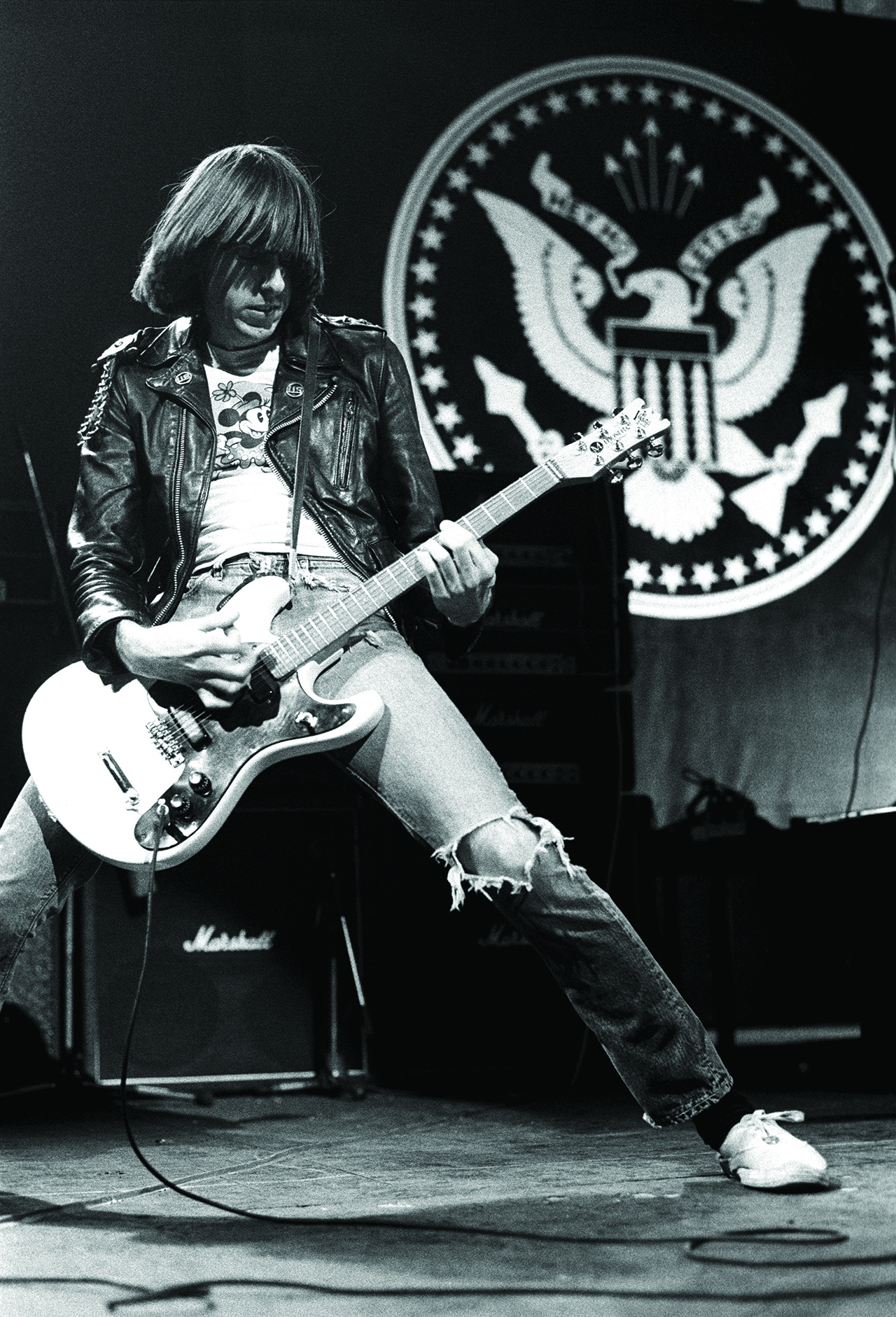
In late 1975, Craig Leon was working as an A&R scout for Sire Records. Leon had seen the band play live, and was impressed enough to pass on a demo they had recorded with producer Marty Thau to his boss, Sire president Seymour Stein, who offered the band a deal. In February 1976, the Ramones entered New York’s Plaza Sound Studio with Leon to produce one of the most epoch-making albums in history. It cost just $6,400 to make.
“Believe me, it wasn’t a particularly live record, like everybody tries to say it was. Joey was coolly professional, unlike Dee Dee, who was almost impossible,” says Leon. “Joey did a lot of punching in and double tracking well. He was a proponent of doing that thing with the panning, like an exaggerated version of an old Beatles stereo mix.”
According to Leon, Joey wanted to be a proper pop star. “He seriously wondered if the Ramones would ever make it as big as Herman’s Hermits or the Bay City Rollers. It was this innocence that was an integral part of the band; the poppiest element was his persona. He was the most disappointed when they didn’t go to No.1 with Blitzkrieg Bop.”
The Ramones’ self-titled debut album was released on April 23, 1976. It peaked at No.111 in the US Billboard Chart, but while its initial impact was small, it was immediate. Across the Atlantic in Britain, reviews in the UK press were enthusiastic, and DJ John Peel hammered it on his influential radio show. A generation of aspirant musicians had found a roadmap to the future of rock. During one long night at the Shepherd’s Bush squat where Sid Vicious lived, I sat with the future Sex Pistols bassist as he played the album on endless repeat, plunking along to Blitzkrieg Bop. “I can play bass now!” he cheerfully announced in the morning.
The Ramones made their British debut on July 4 at the Roundhouse in north London, opening for the Flamin’ Groovies, the night before their own headlining show at Dingwalls. I first met them at their hotel near Euston Station. As I waited in the foyer with manager Danny Fields, it was Dee Dee who appeared first, moaning in a thick Queens accent about having to share a room with Joey. Then came the singer himself, impossibly tall. “Dis is my Bay City Rollers look,” he announced, pointing at his too-short Levi’s, fluorescent green socks and sneakers. Tommy ambled up, clearly the most sensible, before Johnny appeared, smiling and friendly, viewing me as an ally after I’d given his album a glowing review. Although the drummer was supposed to be the band’s spokesman, there was little doubt who was driving things here.
CONVERSATIONS WITH THE RAMONES: PART 2, Dingwalls Dancehall, LONDON, July 5, 1976.
Tell me about your debut album.
Tommy: The stuff on the album is up to two years old. We wanted to get all the old stuff out of the way on this one. We’re really happy with it. We tried to combine as much of the live sound without losing the studio quality.
Johnny: It’s good party music! Sounds good at parties and clubs when we’re hanging out drinking. It’s a good pick-up in the morning too.
Tommy: Yeah, put it on in the morning and it’ll wake you right up.
Johnny: If you smoke a joint it’s good to listen to then!
Joey: You have to wake up, smoke a joint and put it on!
Do you want to leave New York to achieve global fame?
Johnny: We have all intentions of getting out of New York and making it all over. I mean, I love New York but the fans aren’t the sort of fans you want. I want young kids, right up the front. We want to reach high schoolers.
Tommy: We wanna go round the world. We’re not a New York band, man. We’re an American band, and we’ll play any place they’ll come and see us. The first time a lot of people see us, they’re kind of mystified. If you’ve not heard the songs before, they sound like they’re from outer space. People don’t know how to react.
Johnny: We have a lot of drive. I know everybody loses it, but you just have to try not to. We’re not going to change drastically. I guess we’ll do a couple of slower songs… Boyfriend is a slow song. When you play an hour I guess you have to. If we stopped and talked to the audience, we’d add another 10 minutes. We really feel that what we are doing should be done in half an hour.
Johnny, I noticed blood on your guitar just then.
Johnny: I started to bleed at the Roundhouse towards the end. There was blood all over my T-shirt, the worst I’ve ever had it. People wouldn’t believe it, they thought I had blood capsules in my fingers. It used to happen every night, but all of a sudden my fingers got hardened.
Why no guitar solos?
Johnny: They slow things up and bog us down. Most of our songs don’t call for guitar solos. The chords are doing everything. I’m driving away where the guitar breaks would be.
I can hear elements of early rock’n’roll and 60s pop in there.
Tommy: Basically, we’re influenced by late-50s and early-60s music; hit singles mixed with hard rock.
Johnny: There’s 14 singles on our album. We write singles, but the album’s a concept.
Have you got many new songs for the next album?
Tommy: The next album’s been written. We want to call it Pinhead.
When it was released in January 1977, their second album had been renamed Leave Home. Co-produced by Tommy and Tony Bongiovi, anthems such as Gimme Gimme Shock Treatment, Glad To See You Go and a cover of The Rivieras’ California Sun showcased a faster, fuller, more assured band. The album courted controversy with the song Carbona Not Glue, a follow-up to Now I Wanna Sniff Some Glue from the first album (all the band had tried glue-sniffing during their adolescence, but eschewed drugs at the time of the second album, with the exception of Dee Dee). When the company that made Carbona objected to the suggestion that their cleaning solvent would make a good high, the band replaced the song with Babysitter.
Disappointingly for the band, it only reached No.148 in the US chart, though it broke into the British Top 50. Undaunted, the Ramones kicked off their first proper UK tour in May 1977, where they were introduced to the new British pastime of gobbing at the band on stage. Johnny seethed at that, but acknowledged the part Britain had played in his band’s success so far.
“Punk has got real big in England,” he told me. “It takes a long time for things to spread in the United States. People come and see us and like us… they don’t look on us as a new wave group. Nobody’s doing what we’re doing in the States.”
The shows were great, but something had subtly changed within the band’s ranks. Tommy was being sidelined as Johnny stepped up to take control. The guitarist seemed to be conducting the band’s touring operations like a military operation. He would verbally abuse Tommy, regularly punch Dee Dee for any minor infraction and had little time for Joey’s OCD. It must have been frustrating for Johnny that, on stage, all eyes were on Joey, who emanated alien charisma. In front of an audience, the singer seemed to overcome his disability.
“It was pretty fucking bad but when he knew everybody was looking at him, somehow he was able to not give in to it,” says Leigh, “but it bothered him always. There were times I’d have to drive him back to Kennedy airport when he would come in from flights, just so he could walk out the door again and step on to the curb right.”
Conversely, Dee Dee was plagued with self-loathing, exacerbated by Johnny’s bullying. In his 1997 autobiography, the bassist described himself as “the weakest one in the band”, and routinely fell into a heroin haze (a situation not helped by his friendship with Sid Vicious and his girlfriend Nancy Spungen). With Tommy quietly planning an exit strategy from the band he founded, it left Johnny as the strongest Ramone – something which he played to the hilt, having little truck with the failings of his bandmates.
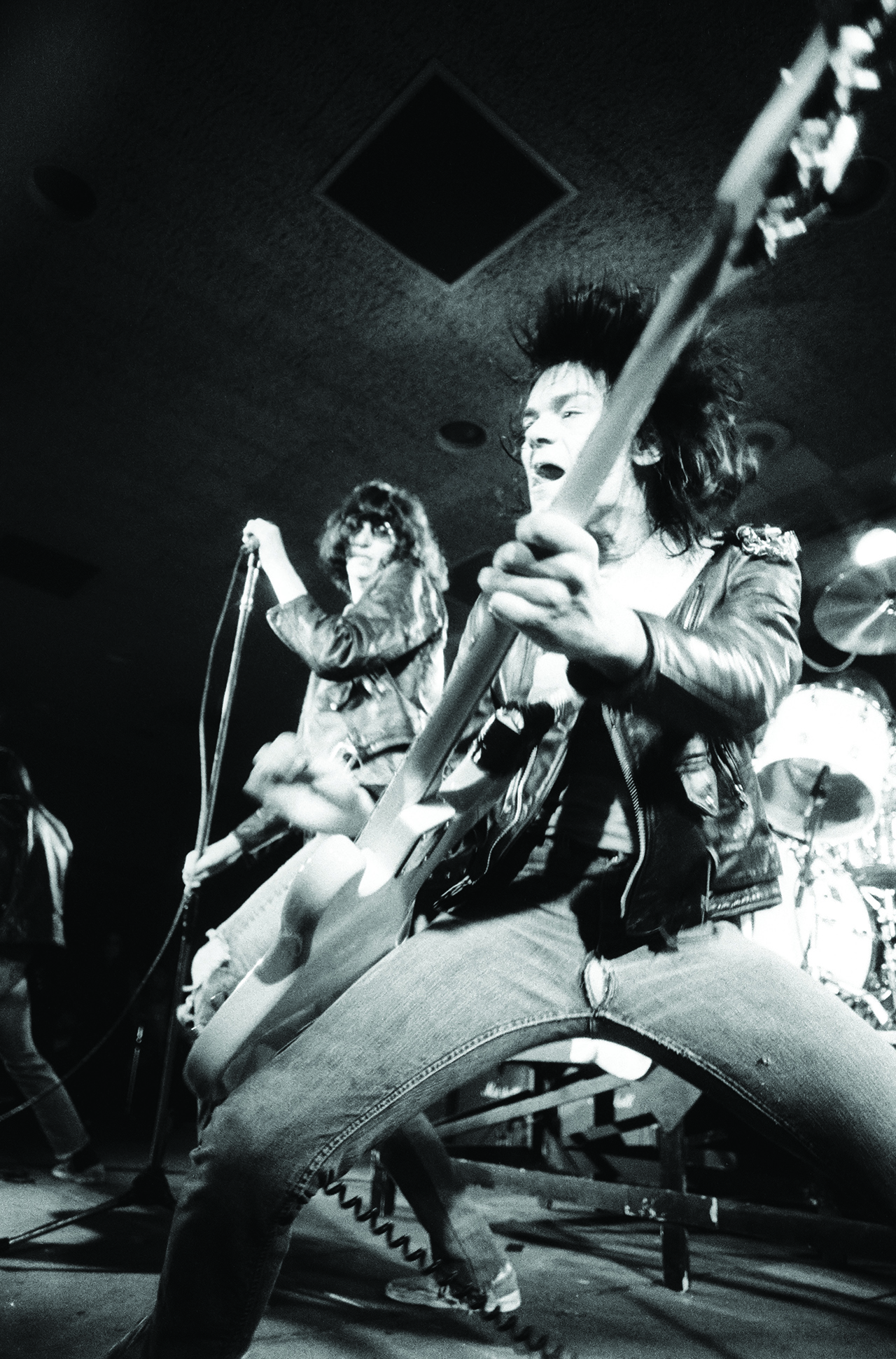
As punk hurtled towards its 1977 apex, the band gigged relentlessly around Europe and the US. In August, they released the classic single Sheena Is A Punk Rocker, followed by their third album, Rocket To Russia, that November. It further brought the band’s bubblegum and surf influences to the fore on the likes of Rockaway Beach, Cretin Hop and their demolition of The Trashmen’s Surfin’ Bird. It also included Teenage Lobotomy, one of the Ramones’ famed odes to mental health. Improving on the success of its predecessor, it gave them their first US Top 50 album.
Behind the scenes, the tensions were boiling over. Unable to deal with Johnny’s abuse and systematic takeover of the band, Tommy finally bailed to focus on production (though he did stay on for another UK tour, where they recorded a New Year’s Eve show at London’s Rainbow Theatre for the double live album, It’s Alive). He was replaced by Marc Bell, formerly of early-70s power trio Dust and Richard Hell & The Voidoids. With the rechristened Marky Ramone on board, the band recorded their fourth album, Road To Ruin, with Tommy and co-producer Ed Stasium. The record saw acoustic guitars and slower songs dropped amid buzzsaw anthems I Wanna Be Sedated, Don’t Come Close and Bad Brain. Most striking of all was Questioningly, a desolate ballad that showcased a new side to Joey’s voice.
CONVERSATIONS WITH THE RAMONES: PART 3, Warner Brothers Boardroom, London, September 22, 1978.
How do you feel about the new album?
Johnny: We thought it was about the best thing we’d done, but the reviews here were bad. We feel the album’s different, it’s a change. The songs grow on you instead of hitting you on the first play. There’s a couple of country’n’western-type songs, more medium-tempo songs. It was just something we had to do. We can’t play just 12 fast songs on every album. We’re not getting the radio play in the US and radio play is very important there.
It’s a progression, but you got shit for it; you can’t win.
Joey: It’s a conspiracy.
Johnny: You can’t have reviewers dictate what you should be playing. They just tore into everything they could find. One guy would say we should get away from that type of mental/bad brain-type song altogether, but we like writing those songs.
Dee Dee: It keeps us happy! Depression can be fun!
Joey: It’s fun to be depressed, just sit in the corner.
Dee Dee: It’s fun, if you don’t take it too seriously.
[US music critic] Lester Bangs suggested you were going through mental pressure when you made the album.
Joey: Close.
Johnny: Well, I guess everybody’s on the verge of a breakdown. We’re hanging on.
Dee Dee: We’re in good shape. I don’t think anybody’s crazy or anything.
Johnny: I think writing those mental/bad brain songs is like a therapy which helps keep us sane.
Joey: It’s like primal therapy, you know.
Johnny: At least we’re aware of all the insanity that’s going on around us.
It’s better than keeping it all bottled up.
Joey: Right, or you’ll blow your brains out.
If somebody’s a genuine Ramones fan they’ll like this.
Dee Dee: Kids have been coming up to me and saying they like the album! Nobody has told me they don’t like the album, except for reviewers. No matter what we’d have done, they would have knocked it. We’re growing, we’re getting bigger, we’re not gonna let no jerks get us upset.
The Ramones were back on the touring treadmill the very next day. This time, they invited me to join them for a ZigZag cover story. Travelling in a basic 70s works outing coach, we drove to Cardiff.
Watching the Ramones away from the stage only confirmed the divisions in the band. Johnny sat at the front of the coach with his girlfriend, Roxy. Dee Dee remained at the back with his new bride, Vera. Joey sat alone, either listening to music or staring at the countryside rolling past.
It wasn’t all grim. At the Hotel Metropole in Leeds, Joey rearranged the letters on the notice board to ‘Otel Metrohole’. “I hope you’re not changing the board,” snapped the woman at the desk. “Who, me?” said Joey with a grin. “Nawww.”
The tour was also the first time I’d witnessed Joey’s OCD up close, most notably when he attempted to cross a road, then turned back and did it several more times. The band kept his condition under wraps, so I just thought he was having a bit of surreal fun.
“Joey’s OCD caused him to be perpetually late,” long-suffering tour manager Monte Melnick told me. “I had to deal with it. One way was to tell him we were leaving an hour before we actually had to leave, because he never checked the clocks.”
Another obsession became evident in an Indian restaurant in Bradford. Joey demanded their hottest chicken vindaloo, which he wolfed down.
“They were obsessed with curry houses,” recalls their PR, Mick Houghton. “They would go for a curry before the show, and always order the hottest thing on the menu. It was like a challenge as they sat there, sweat dripping off their faces. They used to have buckets by the side of the stage because they invariably threw up at some point.”
But even this caused grief. At one show on the tour, it was so hot that Joey took his leather jacket off. “Johnny was looking daggers at him, because he’d dared take his uniform off,” says Houghton. “You weren’t supposed to do that. He commanded they sport the Ramones look from breakfast. They pretty much had to stay in character.”
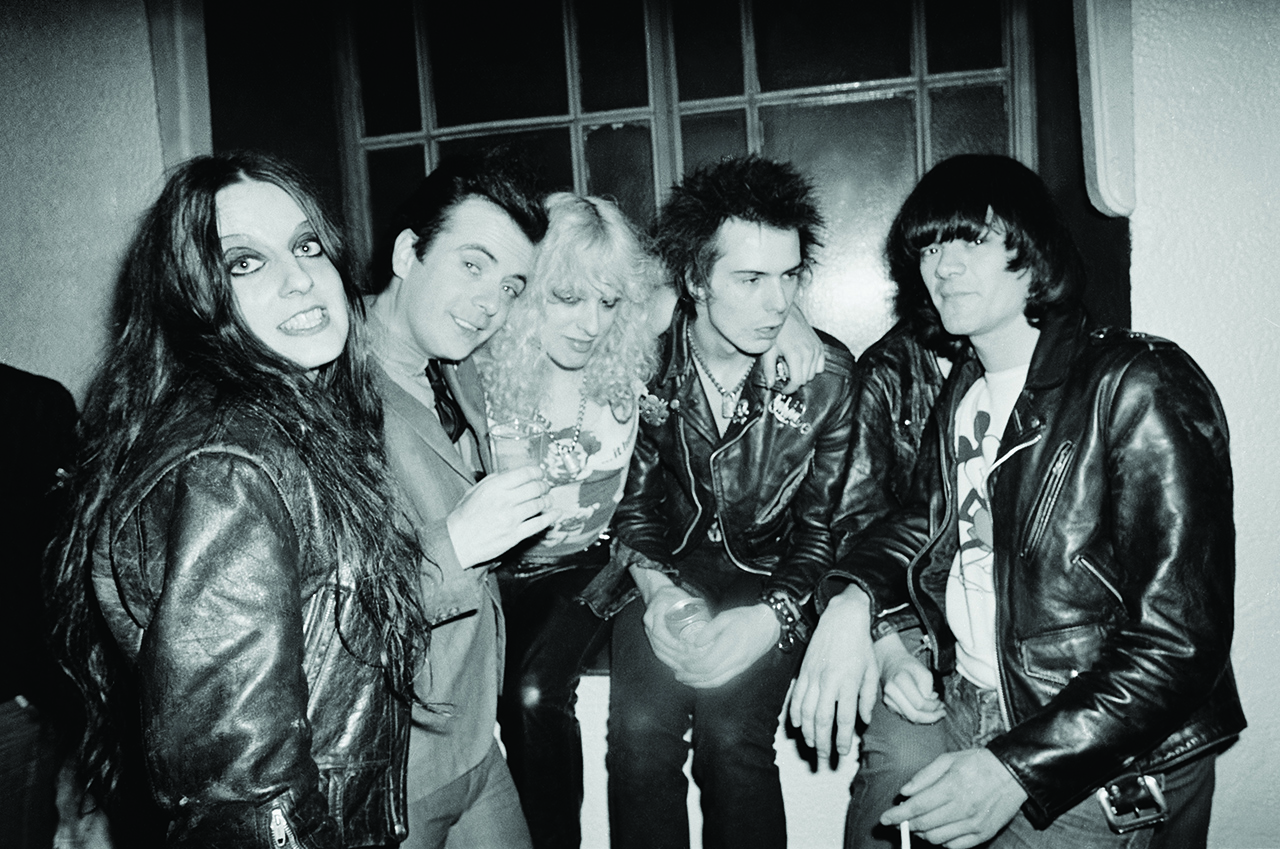
CONVERSATIONS WITH THE RAMONES: PART 4 , Warner Brothers Boardroom, London, September 22, 1978.
Johnny: This whole tour I’ve felt better than I have in the past. Better than the last tours. I dunno why. Usually we get very lonely.
Dee Dee: I just wanted to kill myself but I said “No, I won’t do this, I’m not that crazy.” But I had all these things on my mind. Look out the window and see how high up it was. But I knew I wouldn’t do it.
Any funny things happened to you recently?
Dee Dee: We did have a bunch of people in upstate New York chasing us with crowbars, saying “Take the money and run, huh?”
Johnny: They were just Grateful Dead fanatics. We played an hour and 15 minutes and they wanted us to play for three hours. They were maniacs. We see weirdos every day! You get used to it.
Dee Dee: We’ve been eating a lot of squab lately. When we were touring Sweden, all we could get to eat was squab, which is like a crow. We thought we were eating chicken, but it was a squab!
Johnny: Joey took a bite and ran in the bathroom and threw up. I’ll never forget the stench.
Dee Dee: He wouldn’t come out. Every time that happens we have to take a piss in one of these things [tomato juice bottle] ’cos we can’t get in the bathroom ’cos Joey won’t come out.
Johnny: We pissed in a bottle of Miller and it looked very much like the beer. Then Johnny Rotten picked it up and started to drink some and said “Boy, this stuff tastes like piss!” Nobody’s supposed to pick up strange bottles lying around and drink out of ’em!
So you’re all pretty happy now?
Dee Dee: We’re happy, we’ve always been happy. Just because we’re depressed doesn’t mean we’re not happy.
Except they were anything but happy. Johnny was effectively managing the band, making sure the Ramones’ time was filled with money-making shows or recording (which only got in the way of the gigs). He ran things like a military regiment, deploying his terrifying stare or, in Dee Dee’s case, physical violence, to keep them in check. While Joey battled his OCD, Marky found solace in the bottle and Dee Dee in hard drugs.
The last time I saw the Ramones in action was at the Rainbow Theatre in London in 1980. They had just come through the traumatic experience of recording their fifth album, End Of The Century, with maniacal producer Phil Spector, but had also enjoyed their first proper hit single with a version of The Ronettes’ Baby, I Love You.
By that time, relations within the band had hit a new low. Johnny had stolen Joey’s girlfriend, Linda Daniele, breaking the singer’s heart. While the pair remained in the same band for the next 16 years, they never spoke amicably again.
In truth, by 1980 the spark that had initially fired them was gone. Although Johnny never let up with his relentless touring schedules, they struggled to find a niche in the shiny 80s, going from genuine pioneers to dated anachronism, at least until their music was rediscovered by a new generation in the late 80s and early 90s. When Joey was diagnosed with lymphoma in 1996, he refused to tour again, and the Ramones disbanded (Johnny was furious, but he couldn’t bully Joey back out there this time).
Today, all of the original members are gone. Dee Dee, who left in 1989, died of a heroin overdose in 2002. Joey lost his battle with lymphoma the previous year, his death hastened after breaking his hip in an OCD-related fall (admirably, U2 singer and longtime Ramones fan Bono offered to pay his medical bills). Johnny, who refused to visit his former bandmate when he lay on his death bed, succumbed to prostate cancer three years later. Tommy was the last to pass away, in 2014. But while the original Ramones are no longer with us, their legacy remains untouchable.
“It wasn’t just the music,” Joey said. “Everything changed for the better. There was a whole new attitude now. We put the guts back into rock’n’roll. We rocked the boat.”
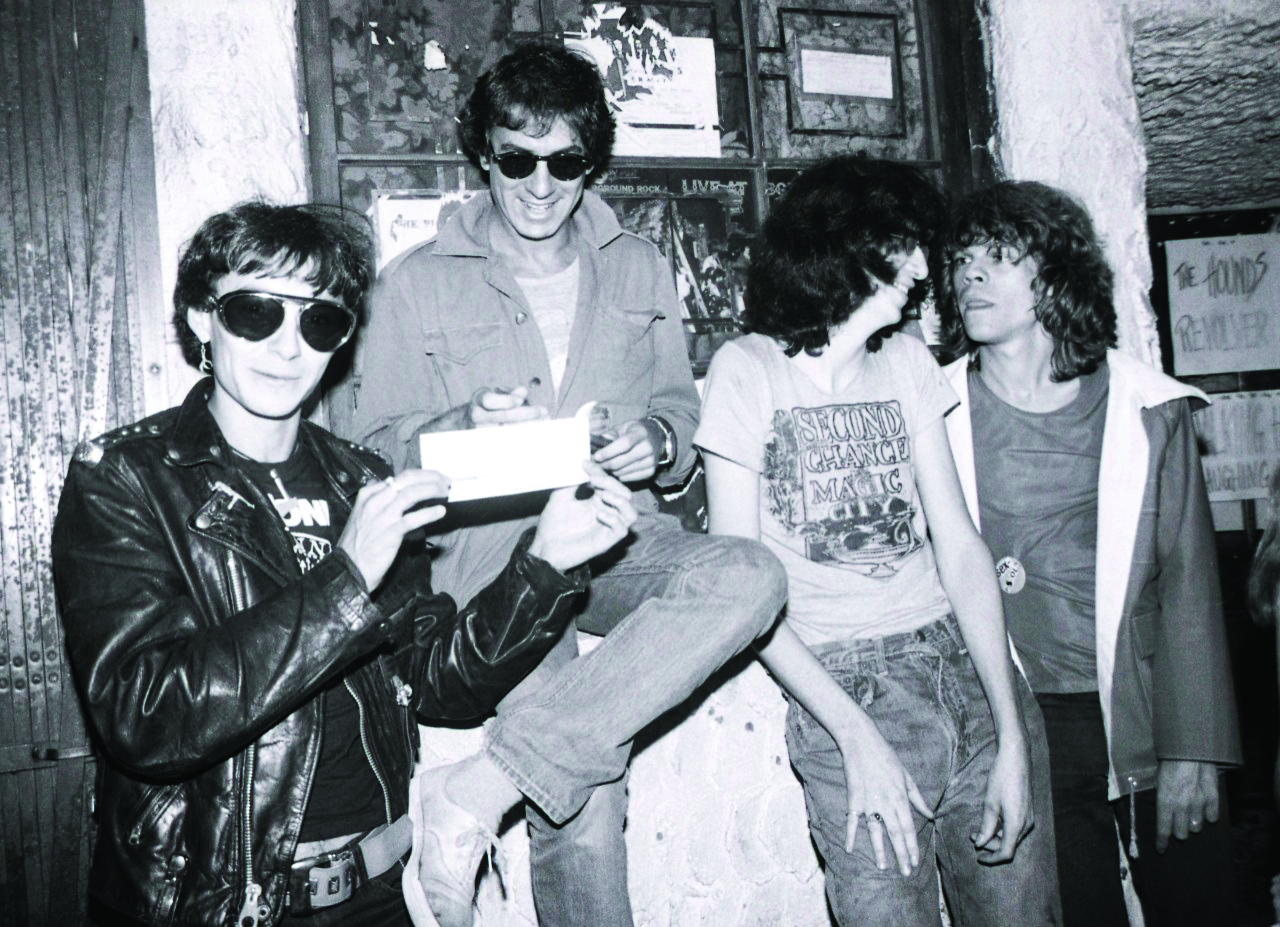
REMEMBERING ARTURO VEGA, THE “FIFTH RAMONE” AND DESIGNER OF THEIR ICONIC LOGO
Next to the Stones’ tongue, the Ramones presidential seal parody is the most recognisable design in rock‘n’roll. Its simple but distinctive mutation of the presidential eagle with a baseball bat has adorned the T-shirts that have been an essential item in any discerning rock fan’s wardrobe for nearly 40 years, also showing up anywhere from high street chain stores to TV sitcoms.
The logo was designed during the first album’s release by the band’s artistic director Arturo Vega, who was often called “the fifth Ramone”. He explained, “I saw the Ramones as the ultimate all-American band. To me, they reflected the American character in general – an almost childish innocent aggression.”
After witnessing the Ramones’ first CBGB gig in August 1974, Mexican-born Vega became such a devoted fan he only missed two of the 2,280 performances they played before splitting in 1996. Joey and Dee Dee both lived in his East Second Street loft, around the corner from CBGBs, and helped him print up T-shirts when they got home from one gig to sell at the next.
T-shirt sales actually kept the band afloat in leaner times, although Arturo recalled having to persuade the band someone would want to buy them. The Ramones became the first punk band to build an established merchandising profile. “They sold more T-shirts than records,” said former manager Danny Fields.
Vega was especially close to Joey, who he tended on his death-bed, then campaigned for the corner of East 2nd Street and Bowery to be renamed Joey Ramone Place. Vega passed away in June 2013, joining his departed brothers but safe in the knowledge he’d left one the biggest visual imprints of all time on the planet.
The 70s Rock Quiz: how well do you know rock’s golden decade?
